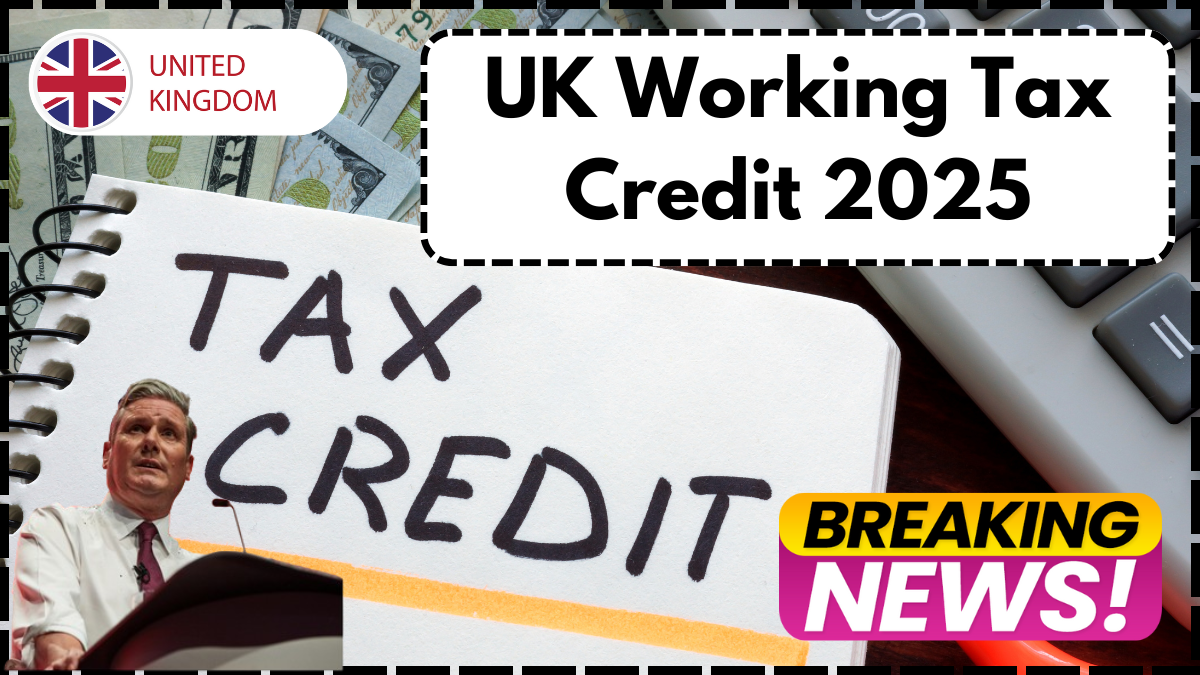Working Tax Credit in the UK officially ends on 5 April 2025. After this date, no further payments will be made, and claimants will transition to Universal Credit or, if eligible, Pension Credit. Letters are being issued to notify individuals about their eligibility and next steps.
This update reflects major changes in the UK’s welfare system and affects thousands of claimants. Here’s everything you need to know about eligibility, working hours, what counts as work, payment amounts, and alternatives post-April 2025.

Key Changes: What Happens After April 2025?
From 6 April 2025, Working Tax Credit will no longer be available. If you’re still receiving it, you will likely be moved to Universal Credit unless you qualify for Pension Credit (for people of State Pension age and above).
Eligibility Criteria Before April 2025
To be eligible for Working Tax Credit before the cut-off, you must already be receiving Child Tax Credit. New claims without an existing Child Tax Credit are not allowed. If you are not eligible, you should apply for Universal Credit instead.
Required Weekly Work Hours
To qualify, you must work a minimum number of hours per week, depending on your personal situation:
| Situation | Minimum Hours/Week |
|---|---|
| Aged 25 to 59 | At least 30 hours |
| Aged 60 or over | At least 16 hours |
| Disabled | At least 16 hours |
| Single with children | At least 16 hours |
| Couple with children (shared) | At least 24 hours total (one must work at least 16) |
Note: A child refers to anyone under 16 or under 20 if in approved education or training. You can still claim Working Tax Credit if you’re on maternity, paternity, or adoption leave.
Special Rules for Couples With Children
Couples may qualify even if working fewer than 24 hours combined if one of the following applies:
- One partner is disabled
- One partner is over 60
- One partner receives Carer’s Allowance or Carer Support Payment (Scotland only)
- One partner is in hospital or prison
- One partner is receiving disability-related benefits
In these cases, the working partner must still be employed for at least 16 hours weekly.
What Qualifies as Work?
Work must be:
- As an employee
- Self-employed
- Or a combination of both
However, self-employment must be commercial, structured, and profit-driven. You may not qualify if:
- You don’t work regularly
- You lack a clear profit-making plan
- You fail to keep business records like receipts or invoices
- Your profit is less than the National Minimum Wage
Essential Self-Employment Documentation
To validate eligibility under self-employment, you’ll need:
- A structured business plan
- Records of day-to-day operations
- Proof of promotional efforts (ads, flyers, websites)
Working Tax Credit Payment Amounts (2025)
Here’s what you could receive until the credit ends:
| Eligibility Element | Maximum Annual Payment |
| Couple applying together | Up to £2,500 |
| Single parent | Up to £2,500 |
| Working 30+ hours/week | Up to £1,015 |
| With a disability | Up to £3,935 |
| Severe disability (additional) | Up to £1,705 |
| Childcare (1 child) | Up to £122.50/week |
| Childcare (2+ children) | Up to £210/week |
How Payments Are Made
- Payments are transferred directly to your bank or building society
- You can choose to be paid weekly or every 4 weeks
- If you’re in a couple, the payment must go into one shared account
- Payments continue until 5 April 2025, the end of the tax year
Already Receiving Working Tax Credit?
If you’re already a recipient, your shift to Universal Credit will depend on whether you experience a change in circumstances. If so, you may be asked to submit a new claim under the Universal Credit system.
Reporting Changes to HMRC
You must inform HMRC within 30 days of major changes, including:
- Job loss
- Starting to work fewer than 16 hours weekly
- Having a child
Failure to report changes could affect your eligibility and future payments.
What to Do After April 2025
- Universal Credit: Most people will need to apply here. It combines six benefits, including working and child tax credits, into one monthly payment.
- Pension Credit: Apply if you and your partner are over the State Pension age.
- Transition Support: HMRC and DWP will send you instructions if you’re affected.
Conclusion
With the end of Working Tax Credit approaching in April 2025, it’s important to understand your eligibility and prepare for the transition. Be proactive: review your circumstances, gather necessary documents, and monitor communications from HMRC. If you’re self-employed, ensure your business records are in order to support any future claims under Universal Credit.
FAQ: UK Working Tax Credit 2025
Q1. When does Working Tax Credit end?
A: Working Tax Credit ends on 5 April 2025.
Q2. What happens after it ends?
A: Most claimants will need to transition to Universal Credit or Pension Credit, depending on eligibility.
Q3. Can I still apply for Working Tax Credit now?
A: Only if you are already receiving Child Tax Credit. Otherwise, you must apply for Universal Credit.
Q4. How do I know if I qualify for Pension Credit?
A: You can apply if you and your partner are over the State Pension age. You’ll also receive guidance from HMRC.
Q5. How often will I receive payments?
A: Payments are made weekly or every 4 weeks, depending on your chosen preference.
Q6. What records do I need if I’m self-employed?
A: A business plan, daily operational records, and proof of marketing like flyers or ads.
For More Information Click Here
Pari is a passionate writer known for captivating stories that blend imagination and reality. Inspired by travel, history, and everyday moments, Pari crafts narratives that resonate deeply with readers.
